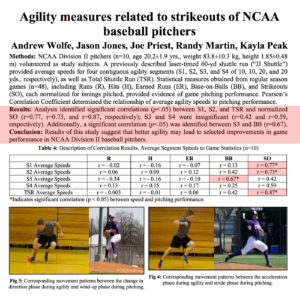 The biggest challenge of training an athlete to become an elite pitcher is stimulating a positive transfer training. This means a series of exercises helping an athlete better perform the skill of pitching. It isn’t enough in today’s game of baseball to call an enhancement in pitching a positive transfer training if the enhancement leads to injury. Therefore, a true positive transfer training would not only be an increase in performance but also a reduction in stress.
The biggest challenge of training an athlete to become an elite pitcher is stimulating a positive transfer training. This means a series of exercises helping an athlete better perform the skill of pitching. It isn’t enough in today’s game of baseball to call an enhancement in pitching a positive transfer training if the enhancement leads to injury. Therefore, a true positive transfer training would not only be an increase in performance but also a reduction in stress.
Unfortunately, currently, the convention wisdom of baseball is that velocity enhancement comes with throwing exercises only. Therefore, weighted baseball training, long toss training and running throw training is the popular forms of training. The reason this is unfortunate is that baseball has a rising injury rate predominately in upper extremity injuries in pitchers (Posner, Cameron, Wolf, Belmont, & Owens, 2011). The American Sports Medicine Institute states that you are five times more likely to have an injury if you pitch more than eight months out of the year (Olsen, Fleisig, Dun, Loftice, & Andrews, 2006). Therefore, why are we training pitchers in the offseason with throwing exercises that are equal to or higher than the stress they experience in the game? Is this why the injury rate is growing and being called an epidemic?
Positive Transfer Training Exercises for Pitchers
There are tons of evidence that pitchers do not need to throw baseballs to improve pitching performance which is the key to increasing performance while reducing the risk of injury. Evidence suggests that better short distance sprinters had more strikeouts and fewer walks (Wolfe, Jones, Priest, Martin, & Peak, 2016). Another study found that lateral to medial jumps was consistently correlated with high throwing velocity (Lehman, Drinkwater, & Behm, 2013). The average throwing velocity was strongly correlated with the average peak trunk rotational velocity for the pitchers in one study. The right and left medicine ball tosses were strongly correlated with throwing velocity specifically (Young, Onate, & Chaudhari, 2014). Finally, more evidence suggests athleticism like vertical jump height and single leg balance correlated to stride length and better pitching mechanics (Fry, Pipkin, Wittman, Hetzel, & Sherry, 2017). This is clear evidence that pitchers only need to throw baseballs to condition their arm for the wear and tear of the session, not use the arm to build the velocity or performance level of the pitcher.
Using these exercises listed in the studies above would build a simple program to start enhancing a pitcher’s performance without putting him at a higher risk of injury. These exercises would include; lateral, medial and vertical jumps, single leg stability training, and sprinting. Following the teachings of Dr. Anatoliy Bondarchuk, most of these exercises would fall into the category of Specific Preparatory Exercises and Specific Developmental Exercises (Bondarchuk, & Yessis, 2010). For example, the lateral, medial and vertical jumps would be considered Specific Development Exercises but if the lateral jump is performed more like the lateral jump in the pitching delivery of the drive leg then it becomes more specific to the skill and is placed in the Specific Development Exercises category which raises its chance of becoming a positive transfer training.
The best practice of implementing these exercises that have strong correlations of increasing pitching performance is to program them into training in their general forms and as a progression of training using variations of these exercises to become more specific to the skill of pitching. This would make me a lot more confident that this programming would not only produce a positive transfer training but reduce the amount of stress being placed on the pitcher's arm.
Share the evidence on instagram:
Positive Transfer Training Reference
Bondarchuk, A., & Yessis, M. (2010). Transfer of training in sports II. Michigan: Ultimate Athlete Concepts.
Fry, K., Pipkin, A., Wittman, K., Hetzel, S., & Sherry, M. (2017). Youth baseball pitching stride length: normal values, and correlation with field testing. International Journal of Physical Education, Sports and Health, 9(3):205-209.
Lehman, G., Drinkwater, E., & Behm, D. (2013). Correlation of throwing velocity to the results of lower-body field tests in male college baseball players. Journal of Strength and Conditioning Research, 27(4), 902-8.
Olsen, S., Fleisig, G., Dun, S., Loftice, J., & Andrews, J. (2006). Risk factors for shoulder and elbow injuries in adolescent baseball pitchers. American Journal of Sports Medicine, 34(6), 905-12.
Posner, M., Cameron, K., Wolf, J., Belmont, P., & Owens, B. (2011). Epidemiology of major league baseball injuries. American Journal of Sports Medicine, 39(8), 1676-80.
Wolfe, A., Jones, J., Priest, J., Martin, R., & Peak, K. (2016). Agility measures related to strikeouts of NCAA baseball pitchers. International Journal of Physical Education, Sports, and Health, 3(2), 188-192.
Young, J., Onate, J., & Chaudhari, A. (2014). Trunk contributions to baseball pitching velocity. An Undergraduate Senior Thesis Presented in Accordance with the Requirements for Graduation with Research Distinction in Biomedical Engineering. The Ohio State University, Columbus, Ohio 43210.

